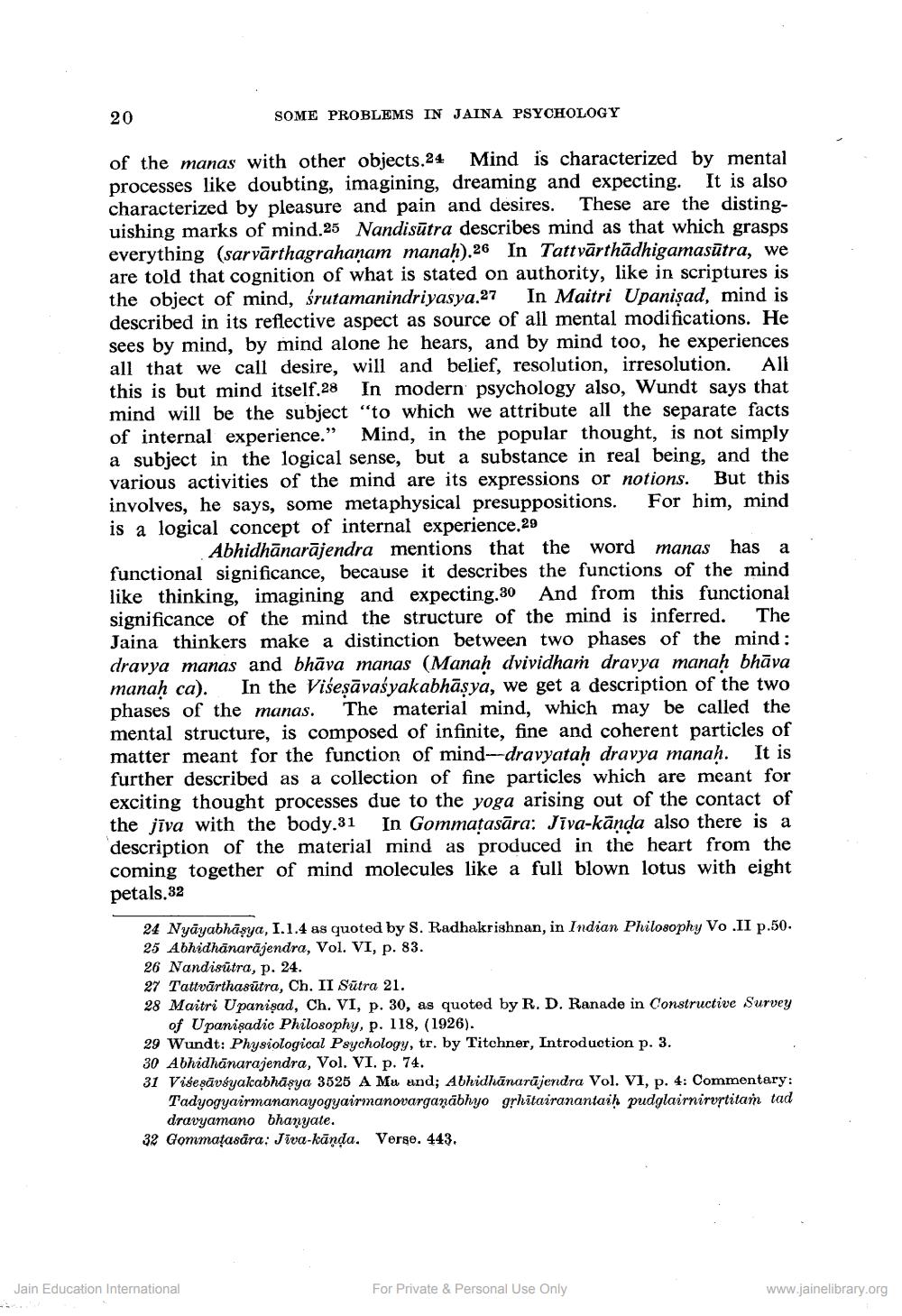________________
20
SOME PROBLEMS IN JAINA PSYCHOLOGY
of the manas with other objects.24 Mind is characterized by mental processes like doubting, imagining, dreaming and expecting. It is also characterized by pleasure and pain and desires. These are the distinguishing marks of mind.25 Nandisūtra describes mind as that which grasps everything (sarvārthagrahaņam manah).26 In Tattvārthādhigamasūtra, we are told that cognition of what is stated on authority, like in scriptures is the object of mind, śrutamanindriyasya.27 In Maitri Upanişad, mind is described in its reflective aspect as source of all mental modifications. He sees by mind, by mind alone he hears, and by mind too, he experiences all that we call desire, will and belief, resolution, irresolution. All this is but mind itself.28 In modern psychology also, Wundt says that mind will be the subject "to which we attribute all the separate facts of internal experience." Mind, in the popular thought, is not simply a subject in the logical sense, but a substance in real being, and the various activities of the mind are its expressions or notions. But this involves, he says, some metaphysical presuppositions. For him, mind is a logical concept of internal experience.29
Abhidhānarājendra mentions that the word manas has a functional significance, because it describes the functions of the mind like thinking, imagining and expecting.30 And from this functional significance of the mind the structure of the mind is inferred. The Jaina thinkers make a distinction between two phases of the mind : dravya manas and bhāva manas (Manah dvividhaṁ dravya manah bhāva manah ca). In the Višesāvaśyakabhāsya, we get a description of the two phases of the manas. The material mind, which may be called the mental structure, is composed of infinite, fine and coherent particles of matter meant for the function of mind-dravyatah dravya manah. It is further described as a collection of fine particles which are meant for exciting thought processes due to the yoga arising out of the contact of the jīva with the body.31 In Gommatasāra: Jiva-kānda also there is a description of the material mind as produced in the heart from the coming together of mind molecules like a full blown lotus with eight petals.32
24 Nyāyabhāşya, I.1.4 as quoted by S. Radhakrishnan, in Indian Philosophy Vo II p.50. 25 Abhidhānarājendra, Vol. VI, p. 83. 26 Nandisutra, p. 24. 27 Tattvārthasūtra, Ch. II Sūtra 21. 28 Maitri Upanişad, Ch. VI, p. 30, as quoted by R. D. Ranade in Constructive Survey
of Upanisadic Philosophy, p. 118, (1926). 29 Wundt: Physiological Psychology, tr. by Titchner, Introduction p. 3. 30 Abhidhānarajendra, Vol. VI. p. 74. 31 Viseşāvsyakabhäsya 3525 A Mu and; Abhidhānarājendra Vol. VI, p. 4: Commentary:
Tadyogyairmananayogyairmanovarganābhyo grhitairanantaih pudglairnirvrtitam tad
dravyamano bhanyate. 32 Gommațasara: Jiva-kānda. Verse. 443.
Jain Education International
For Private & Personal Use Only
www.jainelibrary.org




